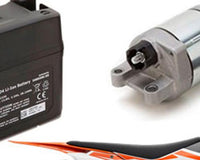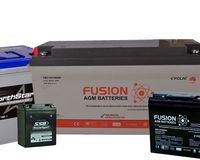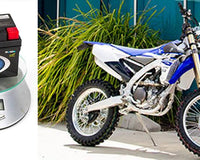Table of Contents
Discovering you have a dead battery just when you’re ready to hit the road can be frustrating. Nonetheless, it happens regularly.
When automobile manufacturers first introduced car batteries, their main functions were ignition and lighting. Today, batteries help with various functions like steering, braking, and comfort features like heating or cooling.
With this stretch in functionality, battery failure is common and usually necessitates a recharge.
Unfortunately, most car owners assume charging a car battery is simple. As a result, they often overlook safety precautions like:
- Using insulated tools
- Handling batteries with PPE (Personal Protection Equipment)
- Ventilating the charging environment
So, let’s delve into how to charge and handle batteries with an explanation of the associated risks.
Tip 1 - Identify the Best Charger for Your Battery

There are various types of battery compositions, which require different charging approaches.
For example, lithium-ion batteries have a protection circuit that turns the battery off if over-discharged.
This discharge level can occur when storing li-ion batteries in a discharged state. Gradually, self-discharge drains the residual charge and causes the elevated discharge.
While the battery is in this off state, a regular battery charger cannot reactivate it. You will need a boost charger to reactivate the protection circuit and trigger a regular charge.
The boost charger applies a small current to raise the voltage between 2.2 V/cell and 2.9 V/cell, activating the protection circuit. After, regular charging resumes.

Alternatively, nickel-cadmium batteries don’t require boost charging when fully discharged. All they need is a constant current (at about 10% battery capacity) and a long charging time (14–16 hours).
Types of Battery Chargers
Charging speed is a standard method of identifying types of battery chargers.
The most basic type is the slow charger. Slow chargers can’t detect a fully charged battery. They stay engaged and therefore need timing when in use. Typically, an empty battery takes 14–16 hours to charge with a slow charger.
The second type is the rapid charger. These chargers take 3–6 hours to charge a battery fully, and have temperature sensors to detect full charge. Once the battery is full, the charger switches to ready mode and stops charging.
The third type is the fast charger. It takes 1 hour to charge a battery with this charger, but not all batteries can handle this charging speed.
For example, lead-acid batteries charge in three stages using constant current and constant voltage. As such, a single fast charge isn’t enough to meet its capacity requirement. One hour of charging only partially charges a lead-acid battery.
So, when selecting a battery charger, always consider your battery’s charging rate (C-rate).
Tip 2 - Ventilate the Charging Environment
Vented lead-acid batteries produce explosive mixtures of hydrogen and oxygen when charging.
An electrical current passes through the electrode (terminals) to the electrolyte (sulphuric acid) when charging. This current electrifies the water in the electrolyte, then releases hydrogen at the negative electrode and oxygen at the positive electrode.

The resulting hydrogen gas is colourless, odourless, and highly flammable. This nature makes it hard to detect without proper equipment and therefore dangerous.
In a poorly ventilated charging environment, the escaping hydrogen gas builds up. Once hydrogen accumulates to 4% of air volume, it becomes explosive. Any spark or flame (such as a cigarette) is enough to ignite and start a fire.
As a result, it’s always essential to have proper ventilation to prevent this hydrogen build-up.
You can also install hydrogen detectors in your ceiling since hydrogen is lighter than air and rises.
Another gas that can develop when charging lead-acid batteries is hydrogen sulfide. This gas is colourless, flammable, and highly toxic. It is present in volcanic gases, sewers and accumulates at the bottom of poorly ventilated spaces.
Prolonged overcharging of a valve-regulated lead-acid battery, with a current greater than 10 A at 60°C, releases large amounts of hydrogen sulfide.
The gas has a noticeable odour of rotten eggs but gradually deadens with prolonged exposure—victims slowly become less aware of its presence.
Immediately after detection, you should:
- Turn off the charger
- Vent the charging environment
- Stay outside until the smell disappears

Tip 3 - Ensure Moderate Ambient Temperatures
Car batteries discharge in a wide range of temperatures, and some can handle extreme temperature fluctuations of between -40° and 80° C. However, charging them requires greater temperature control since excessive heat or cold significantly impacts batteries.
The following table highlights the acceptable charge and discharge temperatures for rechargeable batteries. You will notice the difference in ranges between discharge and charge.
| Battery Type | Lead-acid | Nickel-cadmium | Lithium-ion |
| Charge temperature | –20°C to 50°C | 0°C to 45°C | 0°C to 45°C |
| Discharge temperature | –20°C to 50°C | –20°C to 65°C | –20°C to 60°C |
source: Battery University
Low-Temperature Charging
In cold temperatures, all batteries suffer because their electrochemical processes slowing down while overall internal resistance rises. However, other damaging reactions also occur.
For instance, when charging lithium-ion batteries, the lowest acceptable temperature range is 0°C. Charging below this limit leads to battery damage through lithium plating.
During this process, lithium metal deposits around the anode. Eventually, the deposits create a path through the battery’s separators and cause internal shorting.
On the other hand, vented lead-acid batteries tend to crack their cases in freezing conditions (below -20°C). The cracks cause electrolyte leakage (sulphuric acid), which leads to battery capacity loss and corrosion damage.
High-Temperature Charging
Extreme heat lowers charge acceptance in batteries and eventually leads to capacity loss.
For example, charging nickel-based batteries in high temperatures reduces oxygen generation. This effect tricks chargers into reading the battery as fully charged when it isn’t.
As such, higher temperatures mean less oxygen generation and less charge acceptance. The following table illustrates the correlation between temperature and charge acceptance in nickel-based batteries.
| Temperature | 30°C | 45°C | 60°C |
| Charge acceptance | 100% | 70% | 45% |
source: Battery University
Tip 4 - Determine Your Battery’s Health

Why did my battery fail?
It’s important to distinguish between capacity fade and low charge. A low-charge battery is still reliable after charging, while a battery with faded capacity isn’t. In that case, you might need a replacement.
Your battery’s capacity is the best health indicator since it represents how much energy it can store.
You can measure capacity in ampere-hours (Ah), which reflects how much current your battery can consistently discharge in an hour. For example, an 80 Ah battery can approximately discharge 80 A for 1 hour.
You can also measure capacity in cold cranking amps (CCA). This rating represents your battery’s ability to start an engine in cold temperatures (-18°C). In detail, CCA is the number of amperes your battery can deliver at -18°C for 30 seconds.
Reserve capacity (RC) is also a measure of your battery’s capacity. It represents the number of minutes your battery can deliver 25 A at 27°C. Therefore, a 180 RC rating means 180 minutes of 25 A at 27°C.
According to your battery’s rating, a capacity of below 40% means it needs replacing rather than recharging.
The following table is an example of the technical specifications you can use to determine a battery’s health. It features the ratings of an AGM Deep Cycle battery such as Ah, CCA, and RC.
| Voltage | 12 |
| Capacity Ah (20 hr) | 85 |
| CCA | 620 |
| Reserve Capacity | 160 |
source: HBPlus Battery Specialists
With proper monitoring equipment, you can determine if your battery functions according to its specifications.
Charge Less With an HVT-70D SSB Battery

With these four charging tips, you should have a well-functioning battery. However, If you find yourself in frequent need of charging, your battery might need a replacement.
For a better experience, consider a battery that allows deep discharge and can tolerate extreme climate conditions.
The SSB HVT-70D features a high-tech thermal management system that regulates battery temperature and increases lifespan. You won’t need frequent charging with this battery option.
Visit our website to learn more.
“Excellent battery, bought to replace my 2nd battery under bonnet in Prado, last SSB HVT-70D lasted 7years.”
Darren F.—Verified Buyer

Frequently Asked Questions
Does a revving engine charge a battery faster?
Yes, but only if the battery is in a low state of charge.
Lead-acid batteries only require the amperage your alternator produces when the car is idling. However, when the battery is depleted, it becomes primed to accept more amperage.
Revving an engine causes the alternator to produce more amperage. So, when your battery is in the depleted state, it will accept more amperage and charge faster.
Do short trips drain my battery?
Yes, they do.
The most significant energy demand for your battery is starting the engine. Short trips involve a lot of starts without the necessary recharge time to recover.
How long does it take a battery to charge while driving?
Generally, it takes about 30 minutes to charge a battery while driving. However, several factors may influence your charging time like:
- The battery’s level of depletion
- The battery’s age and condition
- The alternator’s situation









